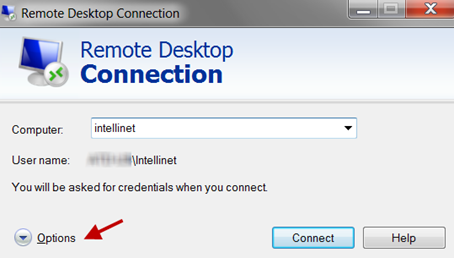Overview: A quick tip about how to get the resolution of a Remote Desktop session just right for your monitor, so you don’t have to deal with scrollbars.
Level: Familiarity with Remote Desktop is assumed.
The screen shots shown below are from a Windows 7 machine.
Remote Desktop Connection Settings
When you launch Remote Desktop, you are initially presented with a very simple window:
To get to all the good stuff, we need to expand the Options. Now 6 tabs are displayed:
On the Display tab, you find the standard screen resolution settings. This is great, but sometimes you need a screen resolution that’s just a little bit different than what’s offered on the slider. For now, just select the resolution that is closest to what you want:
Let’s do one more thing that’s not related to screen resolution before we finish. On the Local Resources tab, choose to have your Printers, Clipboard and Drives available. Under Keyboard, you can also control whether an ALT+TAB works on your primary machine or the remote desktop session (boy did that drive me nuts till I discovered that setting a while back!).
I usually don’t change anything on the Programs, Experience, or Advanced tabs.
Creating an RDP File
Let’s return to the General tab. Note the Save and Save As buttons:
The Save As button will prompt you for the location of a RDP (Remote Desktop Protocol) file. I find that using the Desktop is a perfect location for this file – because you’ll actually launch Remote Desktop from this file after it’s set up. Note in the following screen shot that I put “Home_Monitor” in the name:
Editing the Screen Resolution Size Within the RDP File
Go find the file you just saved; right-click it and choose to open with Notepad (or the text editor of your choice).
After you open the file in Notepad, see the screen resolution settings near the top (which came from the Display tab). Here’s the fun part – you can adjust the “desktopwidth” and “desktopheight” to the precise pixel settings you want. For example, I have one RDP file I like to use which is set to 1890x1000.
On my desktop currently, I have two RDP files which connect to Client ABC: one file which is set to my optimal laptop resolution, and another file which works better with my extra monitor at home. Depending on how & where I want to work at the time, I use the appropriate RDP shortcut on the desktop to launch the Remote Desktop session. Note that the file is specific to one connection.
Here’s to no more scrollbars!








